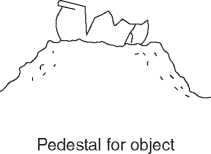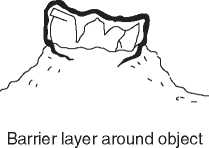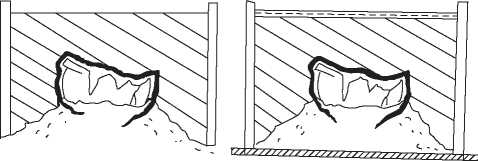From the archaeological processing laboratory where sorting, labeling, classifying, and ordering is performed, some artifacts may be identified for further study by specialists. As unstable finds are identified, many may be sent to the conservation laboratory for conservation treatment. Conservation is a highly technical and time-consuming process that includes examination and analysis; treatment design and proposal; application and interpretation; data and documentation.
In the conservation laboratory, conservators may continue to excavate a block lift or they may perform analyses that will identify materials of construction, techniques of manufacture, and products of deterioration (Figure 1). At other times the recovered finds are so fragmentary or exotic that classification is only possible after the conservator has read or deciphered it. Like a detective, the conservator prepares the fragmentary clues from an excavation so that the attributes or identifiable features of an artifact can be interpreted by other specialists (such as numismatists, archaeo-botanists, faunal experts or specialists in ceramic, textile, metal or lithic technologies) depending on the nature of the site (habitation, quarry, religious, art, etc.). Sometimes the process of conservation can help discover more about intangible aspects of human behavior and the relationships between activities and objects from a particular time and place.
Informed examination of cultural objects forms the basis for all future conservation action. Commonly referred to as a condition assessment, this process may involve procedures that have a small physical effect on the object such as solvent or pH testing of surfaces or the removal of small samples for microscopic inspection, microchemical testing, or instrumental analysis. In addition to a description of all procedures used, a justification should be made and permission attained for sampling, destructive testing, or otherwise unusual procedures. All documentation generated from these efforts should become part of the written record.
For the conservator, the treatment design is a flexible plan that may be modified as the process continues. Only treatments that are judged to be suitable to the preservation of the esthetic, conceptual, and physical characteristics of the cultural property should be recommended and approved. Understanding what constitutes a responsible treatment comes after thoughtful and informed judgment of how the materials of construction, the techniques of manufacture, and the products of deterioration have presented the current condition. A treatment proposal is developed after thoroughly considering the physical characteristics, condition, and specific needs of the cultural property within the context of its discovery, interpretation, and intended use. The proposal also takes into account the physical environment where the finds will be located and the likelihood of continuing care, the potential risks of treatment to the objects, the available resources of equipment and supplies, the limits of personal competence, and the safety of the treatment for personnel, the environment, and the public. A treatment proposal or plan should be approved in writing by the responsible custodian of the cultural property.
The choice of materials and methods for a treatment application should not be formulaic. The potential to cause further deterioration or contamination of analytical testing must be contemplated. Current ideas about conservation treatment stress maintenance of the natural unaltered state of excavated finds. This attitude is replacing an older assumption that excavated finds merely illustrate typological-centered research which justifies esthetic restoration. Therefore, while use of and access to collections is encouraged, it is important that treatment for one purpose does not preclude research for other purposes.
Cleaning is one of the most common invasive applications of treatment at an archaeological excavation.



Supportive frame or consolidation layer with infill (dirt, foam, plaster)
Rigid platform and cover
Cleaning involves freeing dirt and impurities from something. The goals for cleaning should relate to the techniques even if it is only a step in the conservation process. In the decision to clean or not to clean, there is always a balance that must be identified and evaluated. How much cleaning is acceptable and how much loss or change is acceptable? Has cleaning been undertaken as part of preparations for accessioning, or as a step in a series involving preservation, study, or analysis? The use of cleaning treatments should be a conscious, conscientious, and well thought-out process and should always be documented with information on any materials and techniques used.
Mechanical cleaning involves the use of an implement or tool. The degree of vibration from the implement that the artifact is subjected to is relative to the amount of control one has over what is being removed and the degree of structural damage that may be incurred. Any of the techniques listed below have the potential to damage, scratch, or alter the overall physical integrity of the materials to be cleaned. Any scratches or additional distortions that are left behind may be misinterpreted in future studies. Proceed with caution and be observant, remembering that ‘less is more’ in the case of mechanical cleaning.
Mechanical cleaning tools (presented from least potential for damage):
• Fine artist brushes can gently dislodge dirt particles.
• Bamboo skewers are thin rods, are pointed at the end, that offer finer and more rigid mechanical ability for cleaning in small areas.
• Utility brushes, including toothbrushes, kitchen brushes, and small whiskbrooms, can scratch surfaces, dislodge soils with parts of object surfaces attached, and push dirt and dust into porous surfaces. The type, length, and pattern of bristle layout can affect softer surfaces. Also, when soils or accretions are harder than the artifact on which they are deposited, the brush may actually cause damage.
• Metal probes, dental picks, needles, and pins are commonly used in archaeology to delicately work through soils next to artifacts. For most archaeological finds, especially examples that are degraded, the use of metal tools requires extreme caution.
• Specialized vacuum cleaners have been used to gently clean delicate surfaces. Removal of molds and dust is most often best accomplished by brushing toward the opening of a small vacuum attachment (the opening must be much smaller than the object being cleaned). However, vacuum cleaning is nondiscriminating in what it picks up.
• Bulb syringes, canned air dusters, and air-brushes, all use compressed air as a force to dislodge unwanted particles from surfaces. These techniques tend to redistribute dust and soil rather than remove it.
• Electric drills, Foredom® flex shafts, Dremel® rotary tools, and vibro-tools are often mentioned for use in the removal of excess rock around fossil samples and are sometimes mentioned for use in soil removal on specimens. The use of these tools requires extreme ability and patience in order to avoid damage. Due to their aggressive nature, they can cause microfractures and pull away surfaces adjacent to the soil.
• Air abrasive tools (miniature sand blasters) abrade and clean using a high velocity air stream and abrasive particles. These tools can easily remove artifact surface and introduce abrasive particles that lodge into porous materials.
• Ultrasonic cleaners and scalers use sound waves (typically at frequencies between 20 and 50kHZ) to dislodge unwanted soil and residue particles from surfaces. Ultrasonic baths often use heat and are known to generate stress fractures in softer materials such as bone and ivory. Ultrasonic scalers are mentioned in the cleaning of fossils and sturdy archaeological objects. They channel the vibratory nature of the cleaning to a blade and without immersion in liquid.
Washing with water removes dirt because it is an excellent solvent. However, when porous, degraded, and weakened structures are cleaned, other reactions may also take place. Water affects porous materials in the burial environment through an exchange of minerals and salts from the adjacent soil. If these excavated materials are then subjected to water cleaning (rinsing, washing, or soaking), it is common to activate the soluble salts which often collect just below the surface. As the artifact dries, these salts tend to crystallize and expand, causing pressures that are enough to pop the surface, effloresce, or powder. The rate of the reaction and type of damage will depend on the porosity and surface condition of the artifact material.
Water is rarely pure. Waters that contain significant proportions of calcium and magnesium are difficult to wash with and are considered ‘hard’. They may actually add dissolved minerals to porous materials. Softened waters and commercial-scale remover additives alter the mineral content by adding acids and sequestering agents. Washing with additives adds new material to the artifact. Reversed osmosis, distilled, and de-ionized water are often mentioned with artifact cleaning because they influence the cleaning process. Careful consideration is always required for any aqueous cleaning, but, if used, it is critical that artifacts and fragments be supported completely throughout the process.
An alternative to immersion or soaking an object in a bath is spot cleaning. Spot cleaning may involve application of water or solvent to a small area using a fine watercolor brush or swab. In the treatment documentation, a sketch or marked digital image of the spot should be included so the cleaned or affected area is identifiable in the future.
Chemical solvents are used for cleaning because they can remove contaminants. When deciding which solvent might be best to remove a particular contaminant, it is necessary to consider factors such as chemical type, evaporation rate, solubility parameter, toxicity, and flammability. Because most chemical solvents contain more than one component, purity is also a concern. Solvents used on objects should not include colored or nonvolatile impurities. Material Safety Data Sheets (MSDS) should be checked for solvent composition information and storage recommendations.
Chemists usually classify solvents by the most reactive portion of their molecule. From an application standpoint, solvents that are miscible with water are considered polar, while those that are not, are nonpolar. Water or H-O-H is reactive at the O-H bond. Water generally dissolves soils effectively, while greases and oils are better dissolved by less polar solvents such as the hydrocarbons.
When using soaps, detergents, bleaches, or chemical reagents, it is important to prepare for adequate rinsing or flushing. These additives are not meant to stay in materials to be cleaned and even careful flushing after the application of a detergent, for instance, does not guarantee that all of it has been removed. The remaining contaminates could affect obtaining a date, DNA analyses, or a promise to descendants. Though their use is found in the literature, bleaches are truly problematic as they are very difficult to flush and continue to have on-going effects long after application, including possible recrystallization problems. Likewise, acid treatments once commonly used in archaeological field schools to remove unwanted carbonate-based accretions are now discouraged because they are difficult to control and they continue to cause degradation years after application.
Coatings, consolidants, and adhesives have a long history of use in the conservation of excavated finds. The use of film-forming polymers enables the same product to serve as a coating, consolidant, or adhesive depending on how it is mixed with a liquid and how it is applied. Polymers are large molecules that are made from the chain-like formation of smaller identical molecules involving a chemical reaction. Both natural and synthetic film-forming polymers have been used to impart structural stability to fragile materials. Synthetic polymers are generally considered more versatile to use and do not deteriorate as quickly. Making recommendations in favor of particular film-forming polymers is difficult without the consideration of many factors. Typically, there are multiple grades for a product; manufacturers often change the composition, and some have synonymous names that are used in different markets. Consideration of a polymer’s working properties and its effects on later analysis is critical before it is used on cultural property. Guidelines for the selection of accepted materials used in conservation treatments include chemical and physical compatibility with the cultural property; ability to distinguish the treatment from the composition materials of the cultural property; chemical and physical stability; and removable with the least amount of damage to the cultural property, should it become necessary.
Coatings have been recommended in the past as a covering for objects. Coatings may enhance an object’s appearance by unifying the surface with gloss and texture. While a coating does provide some measure of mechanical protection for a delicate surface, it will decay. Many coating films become yellow, lose transparency, or become brittle with age. Others may become sticky and attract dust, and some may enhance the destruction of soluble salts that can build up and break apart the structure below the intact film layer. Protective coatings are not recommended and should never be standard practice.
Consolidants are low concentrations of adhesive polymer in liquid form which are sometimes applied to materials that are unstable and have lost their own cohesive qualities. The low concentration ideally allows for deep and thorough penetration. The use of consolidants in the field has been mentioned, but in that context, it is usually best to use them to consolidate a soil collar for the object rather than the object itself. While a consolidation treatment applied directly to inherently fragile material may be the only way to stabilize the structural form or surface quality, it is a decision that cannot be taken lightly because it comes with potentially permanent repercussions.
Adhesives are substances that are used to hold two surfaces together by means of a join. The adhesives used for conservation are generally applied as a liquid, but they may also be activated by heat or pressure. Making recommendations in favor of particular adhesive products is difficult because there are many factors to consider. Manufacturers of adhesive products often change the composition of their products; there may be multiple grades for a product, and some have synonymous names that are used for them in different markets.
Synthetic polymer products have been used to adhere, consolidate, and stabilize archaeological finds. They are generally grouped based on their chemical structure. There have been numerous studies devoted to the advantages and disadvantages of particular adhesives, so an informed choice based on suitable chemical properties is possible. A basic list of synthetic polymers that have been used on archaeological finds includes the following.
• Acrylic polymers: acrylic or methacrylate polymers; acrylic monomers including cyanoacrylates; acrylic emulsions and dispersions.
• Cellulosic polymers: ethers; esters including cellulose acetate and cellulose nitrate.
• Cross-linking polymers: silcone rubber; polyester; polyurethanes; epoxy resin; formaldehyde resins.
• Hydrocarbons: polyethylene/vinyl acetate; paraffin wax; synthetic rubber.
• Synthetic thermoplastics: poly(vinyl chloride); poly (vinylidene chloride); polystyrene; poly(ethylene glycol); soluble nylon.
• Vinyl acetate derived polymers: poly(vinyl acetate) emulsions; poly(vinyl acetal); poly(vinyl butryal).
After an adhesive is selected, re-assembly of fragmentary finds may begin. This process is sometimes referred to as reconstruction (to construct again), restoration (to bring back to original condition), mending (to make repairs), or bonding (to fasten together). In contrast, the word ‘conservation’ may include a range of activities that prevent damage, engage a technical study of materials or the study of deterioration processes, treat damaged items by stabilizing them with minimal intervention, or restore damaged items through the addition of new materials the compensate for the losses due to damage. Reassembly is generally considered a part of the conservation treatment process that joins together multiple parts that have become separated through breakage. The best results for accurate reassembly involve the use of trained skill, a sand-box, sand-bags, clothes pins, and padded clamps together with gravity-based positioning. When fragmentary objects such as vessels are ‘built up sherd by sherd’, there is better keying or alignment. By placing the join line of two pieces in a horizontal position within the sandbox, gravity and balance will indicate the correct alignment (hand holding or tapes can be avoided). After a join is set, the pieces may be repositioned so that the next join is horizontal. Unsatisfactory reassemblies usually occur if groups of pieces are first joined together into groups and then as a few large pieces because the alignment between the larger pieces is poor.
The issue of whether the join itself will be reversible and stable cannot be overlooked. While it may be possible to re-dissolve a spot of ‘set’ adhesive with solvents, it is rarely possible to do this when the adhesive has entered porous structures or has ‘fixed’ the keys of a break that make up a join. This penetration is often impossible to remove even with aggressive treatments. In addition, all film-forming polymers are sticky when liquid and take up space when dry. The alignment of an adhesive join should be considered the result of a permanent subjective process. Thus, alternatives to a reassembly should always be considered before any adhesives are selected and used.
Restorative methods of stabilization often include the compensation of losses; however, it is important that any compensation technique should be reversible and should not modify, remove, or obscure original artifact material. Restorations are useful when the goal is to help scholars and the public to more readily understand an otherwise fragmentary object or structure. The use of plasters, waxes, and synthetic fillers, as well as armatures and hardware attachments, is common. The techniques used to restore artifacts to esthetic wholeness, the types of materials, their techniques of application, and their stability over time are well known, but they can be problematic. Materials used may penetrate porous objects and become functionally permanent, they may initiate additional chemical reactions causing degradation, and can contaminate or inhibit future analyses. A restoration that includes loss compensation will also conceal the information provided by broken edges.
The following points should be considered prior to any treatment involving adhesives, consolidants, coatings, or restorative fills be undertaken:
• Has information for planned sampling for analysis been identified and considered?
• Is the individual doing the proposed restoration able to properly key the fragments together accurately in their original positions?
• Has there been warping or natural expansion during or since the breakage?
• Will the adhesive be used in the joins measurably add to the overall dimensions of the whole?
• Is the adhesive re-soluble in an appropriate solvent?
• Although the join may be reversible, will removal of adhesive residues affect the texture, appearance, and inhibit further analysis?
Methods of treatment become recognized as acceptable after appropriate testing and publication in peer-reviewed literature. Appropriate methods are selected based on the competence of the conservator after experimental evaluation using mockups or samples. Documentation enables an understanding of what was removed, and perhaps more importantly, what may have been added. While modern conservation presumes to include documentation for all treatments, this has not always been common practice with archaeological processing. Items found with undocumented repairs or preservatives are common in collections. They are inadvertently compromised for further scientific analysis and typically require further conservation treatments to be suitable for display or illustration.
Treatment documentation should include reference to the object treated, the date of treatment completion, any deviations from the proposal, and a description of any material removed, obscured, or added (cleaning agents, solvents, bleaching agents, chemical reagents, surfactants, and consolidants). The sources of added materials including manufacturer, proprietary name, and chemical composition should also be included where known. All documentation generated during the execution of a treatment or stabilization effort should become part of the written record. Graphic documentation (drawings or photographs) should be labeled before treatment, during treatment, and after treatment. Alternatives to invasive treatments are commonly referred to under the term, ‘preventive conservation’.




 World History
World History









